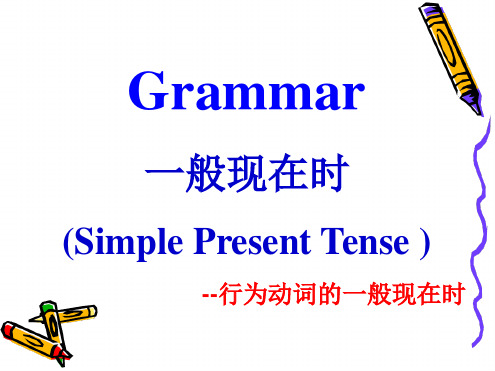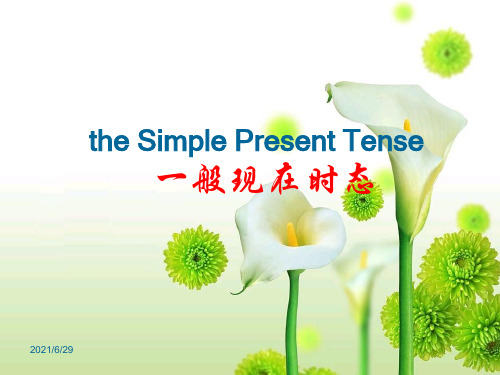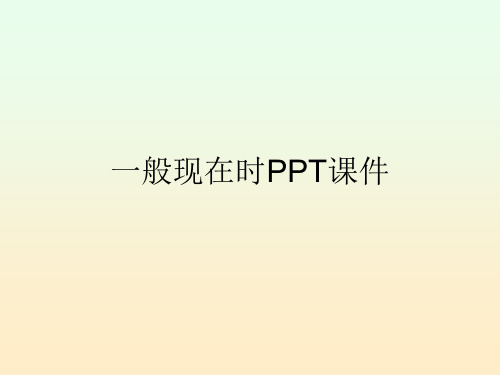初中英语语法中的一般现在时PPT课件
合集下载
七年级英语一般现在时PPT课件.ppt

7. I often __p_l_a_yfootball at weekends. (play) 8. Simon's father often __w__a_t_cfhooetsball games on
TV. (watch)
9. Millie __r_e_a_d_ sbooks at home. (read)
2、连系动词 例句:He is ten years old .
I feel happy .
3、助动词 例句:Do you have a sister?
He doesn't speak English.
4、情态动词
例句:We must go now.
She can speak English.
一般现在时的构成:
My name is Amy. He is ten years old.
---be动词的一般现在时。 I often play football after school.
He watches TV every day. -----行为动词的一般现在时
动词的种类
行为动词的一般现在时的构成:(看例句并总结规律, 注意观察红色和蓝色字体。) 1、I play football every day . 2、You play football every day . 3、My friends play football every day . 4、He plays football every day . 5、Tom plays football every day . 6、My brother plays football every day . 总结规律: 当主语是第一、第二人称和第三人称复数时,行为动 词使用其原形。当主语是第三人称单数时,行为动词 使用其第三人称单数形式。 行为动词一般现在时的第三人称单数形式
初中英语一般现在时学习课件(共25张ppt)

let?schant系动词be的一般现在时实义行为动词的一般现在时一系动词be的一般现在时1肯定句的构成
一般现在时 The simple present tense
Let's chant
Like,like, what do you like? Running, running, I like running. Like, like, what does he like? Swimming, swimming, he likes swimming. Like, like, what does she like? Fishing, fishing, she likes fishing.
二、一般现在时的构成
系动词be的一般现在时 实义(行为)动词的一 般现在时
• (一)、系动词be的一般现在时
1、肯定句的构成: 主语 + be + 其他
The girl is my friend.
2.be动词包括哪些 ?
am is are 什么时候用is? 什么时候用am? 什么时候用are?
be 的用法口诀 我用am,你用are, is连着他,她,它; 单数名词用is, 复数名词全用are。
4. He always_______(wash) clothes at 7:00.
5. They ______ (watch) TV on Sundays.
6. Miss Li_______ (teach) Chinese. 1. Look at the animal, it ____(have) four legs.
Exercise
• • • • • • • 1、Kitty ( ) an English girl. 2、We ( ) students. 3、I ( ) from Taizhou. 4、She ( ) tall. 5、Lucy and Lily ( ) good friends. 6、Those chairs ( ) broken. 7、The bag ( ) mine.
一般现在时 The simple present tense
Let's chant
Like,like, what do you like? Running, running, I like running. Like, like, what does he like? Swimming, swimming, he likes swimming. Like, like, what does she like? Fishing, fishing, she likes fishing.
二、一般现在时的构成
系动词be的一般现在时 实义(行为)动词的一 般现在时
• (一)、系动词be的一般现在时
1、肯定句的构成: 主语 + be + 其他
The girl is my friend.
2.be动词包括哪些 ?
am is are 什么时候用is? 什么时候用am? 什么时候用are?
be 的用法口诀 我用am,你用are, is连着他,她,它; 单数名词用is, 复数名词全用are。
4. He always_______(wash) clothes at 7:00.
5. They ______ (watch) TV on Sundays.
6. Miss Li_______ (teach) Chinese. 1. Look at the animal, it ____(have) four legs.
Exercise
• • • • • • • 1、Kitty ( ) an English girl. 2、We ( ) students. 3、I ( ) from Taizhou. 4、She ( ) tall. 5、Lucy and Lily ( ) good friends. 6、Those chairs ( ) broken. 7、The bag ( ) mine.
(完整版)一般现在时课件

一般疑问句: Be+主语+表语?
Are your parents doctors? Yes, they are./No, they aren’t. Is Mr Long 28 years old? Yes, he is./No, he isn’t.
2021:表示行为动作的词语
3. 经常、习惯、反复做的事情 We have lunch at 12:30. We go to school on Monday.
2021/6/29
be 动词的一般现在时:
be: am, is, are
用be动词的适当形式填空: I ‗a‗m‗‗ he‗‗is‗‗ she ‗i‗s‗‗
iti‗s‗‗‗ Tomis‗‗‗‗
否定句:
☺主语(I/We/You/They)+do+ not+动词原形+其他 I don’t watch TV on Sunday. ☺主语(He/She/It)+does +not+动词原形+其他 He doesn’t watch TV at home on Sunday.
2021/6/29
Practice:
5. 特殊情况 have– has
把下面的行为动词变为第三人称单数形式:
go―goes
carry―carries ride―rides
open―opens
have ― has
teach―teaches brush― brushes dey―deys
play―plays
finish―finishes
2021/6/29
1.一般情况直接加s e.g. reads, plays, works, makes
《一般现在时讲解》课件

一般现在时可以用来描述当前的情况或状态,例如“我现在很开心”、“她现在 是一名学生”等。这种时态强调的是当前的情况或状态,而不是过去或未来的变 化。
表示客观事实或普遍真理
总结词
描述不受时间影响的客观事实或普遍真理。
详细描述
一般现在时可以用来描述不受时间影响的客观事实或普遍真理,例如“地球是圆的”、“水在100摄氏度下沸腾 ”等。这种时态强调的是事实的普遍性和客观性,不会因为时间而改变。
I eat an apple every day. (我每天吃 一个苹果。)
结构
一般现在时的基本结构是“主语+谓 语+(宾语)+(其他成分)”,其中 谓语动词以原形或第三人称单数形式 出现。
一般现在时的特点
01
02
03
强调现在
一般现在时强调当前时间 点,表示动作或状态正在 发生或存在。
普遍性
一般现在时用于描述普遍 存在的真理、事实或习惯 性行为,不受时间限制。
总结词
动词形式不同
详细描述
一般现在时的动词形式为原型,而一般将 来时的动词形式需要用will+动词原型。
与现在进行时的对比
总结词
动作状态不同
详细描述
一般现在时表示现在的动作或状态,强调动作的持续性 ;而现在进行时表示正在进行的动作或状态,强调动作 的进行过程。
总结词
用法侧重不同
详细描述
一般现在时更侧重于描述习惯性、经常性的动作或状态 ,而现在进行时则侧重于描述当前正在发生的动作或状 态。
一般现在时的用法
表示习惯性或经常发生的动作
总结词
描述日常生活中的常见行为或习惯。
详细描述
一般现在时用于描述日常生活中的常见行为或习惯,例如“我每天早上起床” 、“他每周去健身房锻炼”等。这种时态强调行为的频繁性或习惯性,而不是 特定的一次性事件。
表示客观事实或普遍真理
总结词
描述不受时间影响的客观事实或普遍真理。
详细描述
一般现在时可以用来描述不受时间影响的客观事实或普遍真理,例如“地球是圆的”、“水在100摄氏度下沸腾 ”等。这种时态强调的是事实的普遍性和客观性,不会因为时间而改变。
I eat an apple every day. (我每天吃 一个苹果。)
结构
一般现在时的基本结构是“主语+谓 语+(宾语)+(其他成分)”,其中 谓语动词以原形或第三人称单数形式 出现。
一般现在时的特点
01
02
03
强调现在
一般现在时强调当前时间 点,表示动作或状态正在 发生或存在。
普遍性
一般现在时用于描述普遍 存在的真理、事实或习惯 性行为,不受时间限制。
总结词
动词形式不同
详细描述
一般现在时的动词形式为原型,而一般将 来时的动词形式需要用will+动词原型。
与现在进行时的对比
总结词
动作状态不同
详细描述
一般现在时表示现在的动作或状态,强调动作的持续性 ;而现在进行时表示正在进行的动作或状态,强调动作 的进行过程。
总结词
用法侧重不同
详细描述
一般现在时更侧重于描述习惯性、经常性的动作或状态 ,而现在进行时则侧重于描述当前正在发生的动作或状 态。
一般现在时的用法
表示习惯性或经常发生的动作
总结词
描述日常生活中的常见行为或习惯。
详细描述
一般现在时用于描述日常生活中的常见行为或习惯,例如“我每天早上起床” 、“他每周去健身房锻炼”等。这种时态强调行为的频繁性或习惯性,而不是 特定的一次性事件。
一般现在时ppt课件完整版

不可数名词作主语时,谓语动词用单数 形式。
可数名词单数作主语时,谓语动词也用 单数形式。
例如:Water is essential for life.(水 对生命至关重要。)/ A book is on the table.(一本书在桌子上。)
例外情况总结
当主语为并列主语时,谓语动词的数要与靠近它的主语保持一致。
练习3答案
reads。解析:主语 She 是第三人称单数 ,且时间状语为 on weekends,表示经 常性动作,所以谓语动词要用单数形式 reads。
THANKS
时间状语分类及举例
表示经常性或习惯性的动作
always, usually, often, sometimes
表示现在的状态或特征
now, at present, these days
表示普遍真理或客观事实
in general, as a rule
频率副词分类及举例
01
高频副词
always, constantly, continually
注意区分完全否定和部分否定。完全 否定表示全部否定,而部分否定表示 部分否定。例如,“None of the students passed the exam.”(没 有一个学生通过了考试)是完全否定 ;“Not all of the students passed the exam.”(并非所有学生都通过 了考试)是部分否定。
does he work?等。
动词短语和情态动词的变化规则
03
动词短语中的动词和情态动词后接动词原形,如I can swim,
they often go out等。
02 肯定句结构与用法
主语+动词原形+其他成分
(完整版)一般现在时PPT课件.ppt

7. Tom can not walk fast because he _c_a_r_r_ie_s(carry) a heavy box.
用动词的适当形式填空
1.She ____(go) to school at eight o’clock.
2. He usually _____ up at 17:00.(get )
直接加s
Fly-flies;ห้องสมุดไป่ตู้stay-stays
• 第三节 • 特殊疑问句
• I clean the window at home on Saturdays.
• 1、对主语提问:
• Who cleans the window at home on Saturdays?
• 2、对宾语提问:
Has David got a goal?
7. We have four lessons.(否定句) We don’t have four lessons.
8. Nancy doesn’t run fast (肯定句)
Nancy runs fast. 9. My dog runs fast. 否定句:My dog doesn’t run fast.
5. Danny_s_t_u_d_ie_s__(study) English, Chinese, Maths, Science and Art at school.
6. Mike sometimes g_o__e_s_(go) to the park with his sister.
7. At eight at night, she w__a_tc_hes (watch) TV with his parents. 8. _D_o_e_s_ Mike r_e_a_d_(read) English every day?
初中一般现在时ppt

句型转换 1.My brother works in Shenzhen. ______ ______ your brother ________? 2.One of my classmates comes from Australia. ______ ______ one of your classmates______ _______? 3.He does his homework every day.(否定句) He _______ _______ his homework every day. 4.David wants to see me. _______ ______ David _______ to see? 5.She teaches English in No.8 Middle School. ________ ______ she _______ English? 6.My parents live in Chongqing now. ________ live in Chongqing now? 7.They look very young.(一般疑问句) ______ they _______ very young?
2.实义动词的一般现在时句式:
肯定句:
主语(I/We/You/They)+v.+其他
e.g. We study in a high school.
They have a pet.
否定句:
主语(I/We/You/They)+do+ not+v.+其他
They don’t have a pet.
is
to drink
looks
doesn’t do
doesn’t like
七年级一般现在时课件PPT

示例
Do you like apples? 你喜 欢苹果吗?
Am/Is/Are引导的一般疑问句
01
结构
Am/Is/Are + 主语 + 其他?
02
用法
用于询问对方或第三方的身份、特征或状态,其中Am用于第一人称单
数,Is用于第三人称单数和不可数名词,Are用于其他人称和复数。
03
示例
Are they your friends? 他们是你的朋友吗?
用所给动词的适当形式填空
2. My father _______ (work) in a bank. He _______ (go) to work by bus every day.
07
总结回顾与拓展延伸
重点内容回顾
01
02
03
04
一般现在时的定义:表示经常 性、习惯性或普遍性的动作或 状态,以及客观真理或事实。
示例与练习
示例
What do you usually do on weekends? 你周末通常做什 么?
练习
根据所给情境,构造特殊疑问句并给出相应回答。例如,针 对“我昨天去了图书馆”这一情境,可以构造特殊疑问句 “Where did you go yesterday?”并回答“I went to the library yesterday.”。
示例与练习
示例:将陈述句“He likes
playing basketball.”改为一
般疑问句。
01
答案:Does he like playing
basketball?
02
练习:将以下陈述句改为一般
疑问句。
03
She has a new bike.
《一般现在时》课件

主语 + 现在时动词(第三人称单数加-s)
主语 + do not/does not + 现在时动词
3 疑问句
Do/Does + 主语 + 现在时动词?
一般现在时的用法
1
描述现在经常发生的动作
2
She always drinks coffee in the morning.
3
描述习惯或常规
4
I usually go to bed at 10 o'clock.
描述现在正在进行的动作
I am studying English.
描述客观事实或真理
The sun rises in the e词需要加-s,例如:He studies Eng lish.
否定句和疑问句的构成
否定句和疑问句需使用助动词do/does,并把其 放在主语之前,例如:I don't like coffee. Does she like tea?
《一般现在时》PPT课件
一般现在时是描述现在正在进行或经常发生的动作的时态,也常用于表示客 观事实、真理和习惯。
什么是一般现在时
简称现在时
用于描述当前正在进行或经常发生的动作。
描述客观事实、真理、习惯等
一般现在时也常用于描述客观存在的事实、普遍的真理和个人的习惯。
一般现在时的构成
1 肯定句
2 否定句
初中英语语法之 一般现在时 PPT课件 图文

2.用括号内动词的适当形式填空。 1. We often_______(play) in the playground. 2. He _______(get) up at six o’clock. 3.____you______(brush) your teeth every morning. 4. What______ (do) he usually____ (do) after school? 5.Danny_______(study)English, Chinese, Maths, Science and Art at school.
How old _a_r_eyou? Where a_r_e_ they ?
小结:be 动词的一般现在时的句式: 肯定句:主语+be+表语(n., adj.等)
否定句:主语+be+ not+表语.
一般疑问句:Be+主语+表语?
特殊疑问句:疑问词+be+主语?
2.实义动词的一般现在时句式: 肯定句: 主语(非三单)+v.原形+其他. 1) I _s_ta_y___ (stay) at home on Saturdays. 2) They h__a_v_e_ (have) sports every day. 3) My parents _g_iv_e_(give) me ten yuan
What _d_o_e_s_ she_w_a_n_t_ (want)? What time _d_o_you_h_a_v_e_ (have) lunch? What time d_o_e_s_she_h_a_v_e(have) lunch?
What _d_o__ you _d_o_(do)? What _d_o_e_s__ she _d_o__(do)? How __d_o_ you_sp__el_l (spell) it? How _d_o_e_s_ he s_p_e_l_l _(spell) it?
2024年中考英语语法复习——一般现在时课件

studies
★以y结尾的单词,但y之前有元音字母时, 直接加s,如:say→says,pay→pays等。
★be 动词的第三人称单数是is。
★have的第三人称单数为has。
2)He/She/It does...的不同句式
① 一般疑问句:Does he/she/it (do)...?
陈述句:He goes to school every day.他每天去学校。 一般疑问句:Does he go to school every day?他每天去学校吗?
b.针对地点提问
Where does he draw? 他在哪里画画?
Where does your brother play games? 你弟弟在哪里玩游戏?
c.针对方式提问 How does she go to school? 她是怎么去学校的? How does he get to the airport? 他是怎么到达机场的? d.针对时间提问 When does Danny get up? 丹尼是几点起床的? What time does your father go to work? 你父亲几点上班?
(这里的run,go,see 就是实义动词,在句 中用原形。)
2.一般疑问句:Do you...?
陈述句:I see the rainbow.我看见彩虹 一般疑问句:Do you see the rainbow?你看到彩虹了吗?
陈述句:Ilike myjourney.我喜欢这次旅行。 一般疑问句:Doyou like your journey?你喜欢你这次旅行吗?
be动词在一般现在时态中的各种句型:
1.肯定句:主语+be+其他
You are a good girl. 你是一个好女孩。
★以y结尾的单词,但y之前有元音字母时, 直接加s,如:say→says,pay→pays等。
★be 动词的第三人称单数是is。
★have的第三人称单数为has。
2)He/She/It does...的不同句式
① 一般疑问句:Does he/she/it (do)...?
陈述句:He goes to school every day.他每天去学校。 一般疑问句:Does he go to school every day?他每天去学校吗?
b.针对地点提问
Where does he draw? 他在哪里画画?
Where does your brother play games? 你弟弟在哪里玩游戏?
c.针对方式提问 How does she go to school? 她是怎么去学校的? How does he get to the airport? 他是怎么到达机场的? d.针对时间提问 When does Danny get up? 丹尼是几点起床的? What time does your father go to work? 你父亲几点上班?
(这里的run,go,see 就是实义动词,在句 中用原形。)
2.一般疑问句:Do you...?
陈述句:I see the rainbow.我看见彩虹 一般疑问句:Do you see the rainbow?你看到彩虹了吗?
陈述句:Ilike myjourney.我喜欢这次旅行。 一般疑问句:Doyou like your journey?你喜欢你这次旅行吗?
be动词在一般现在时态中的各种句型:
1.肯定句:主语+be+其他
You are a good girl. 你是一个好女孩。
一般现在时课件ppt

形式
动词采用一般现在时形式 ,即动词原型或第三人称 单数形式。
一般现在时的特点
普遍性
一般现在时适用于描述普 遍存在的现象、事实或习 惯性动作。
客观性
一般现在时强调动作或状 态的客观存在,不受时间 限制。
习惯性
一般现在时用于描述习惯 性、规律性的动作或状态 。
一般现在时的用法
描述现在的动作和状态
描述普遍存在的现象和事实
选择题练习
总结词
选择题练习是一种常见的练习方式,通过提供多个选项,让学生根据语境选择正 确的答案,进一步巩固一般现在时的用法。
详细描述
在选择题练习中,教师可设计多个选项,每个选项对应不同的动词形式。学生需 要根据句子语境,选择符合时态要求的正确答案。例如,“Do you like to ___(swim/play) in the pool?”,正确答案应为“swim”。
翻译练习
总结词
翻译练习是一种跨语的练习方式,通过将句子从一种语言翻译成另一种语言,让学生更好地理解和运用一般现 在时。
详细描述
在翻译练习中,教师可提供一些英文句子,要求学生将其翻译成中文。在翻译过程中,学生需要准确把握时态的 转换和应用,确保译文符合中文表达习惯。例如,“He ___(live) in New York.”,正确译文应为“他住在纽约 。”
详细描述:一般现在时表示动作或状态的一般情况,不 强调正在进行的动作;而现在进行时则强调正在进行的 动作或正在变化的状态。
详细描述:一般现在时通常用于描述事实、习惯或目前 的状态,而现在进行时则用于描述正在进行的动作或正 在变化的状态。
详细描述:在描述当前情况、事实或习惯时,一般现在 时更为适用;而在描述正在进行的动作或变化的状态时 ,现在进行时更为合适。
七年级英语语法:一般现在时 课件(共17张PPT)

二、将下列句子变成否定式和一般疑问句
1.Her name is Li Ling.
Her name ______ isn’t Li Ling.
Is her name Li Ling ?
2.We go to school at night.
We ________to don’t go school at night.
3).主语+行为动词(speak,say,call,go, run….) 1) I speak English. 2) She/He speaks English. 3) They call me Tom. 4) He runs very fast.
注意:在一般现在时态的肯定句中,当主语是第 三人称单数(she, he, it),行为动词要加-s或者 -es
She can play basketball.
She __________basketball. can’t play
play basketball ? _______ Can she _______
三、单项选择
1. The Browns___a nice car and Brown's brother __ a nice jeep. A. have, have B. has, has C. have, has D. has, have 2. If tt look like? A. is, is B. is, does C. does, does D. does, is
e.g. She likes Maths. doesn’t like 变否定句:She _________Maths. Does she _____ like Maths? 变一般疑问:______
超详细一般现在时讲解ppt课件

→ Can you swim? → I can not swim.
3、 当句子中即没有be动词,也没有情态动 词时,则在主语前加助动词do, does变成问 句;在主语后谓语动词前加助动词don’t, doesn’t变成否定句,助动词后的谓语动 词要变成动词原形。
例:We get up at 7:00 every morning.
初中英语说课稿
一般现在时
八 大
一般过去时 一般将来时 现在进行时
时 现在完成时
态 过去进行时
过去将来时
过去完成时
一般现在时
一、掌握含有be动词的一般现在时的结构。
二、掌握含有实义动词行为动词)的一般现在时的结构。
在含有实义动词的一般现在时中,如果主语是三单,(谓语)动词也要用三单式。
一、一般现在时的基本用法
学生常见错误如下:
(一)be动词与行为动词同时出 现在句子中
(二)单三人称形式易出错 (三)在句式变换时易出错 (四)对do的理解易出错 (五)对主语的数判断有误
(一)be动词与行为动词同时出现在句 子中
(二)单三人称形式易出错
1、 He plaies (play) football very well. 以元音字母加y结尾的动词变单三人称形式 不能把y换成i再加es; 2 、Danny gos (go) to school at 7:10. 与名词变复数不同,变单三人称形式以o结尾
eighteightminusfivethreeminusfive77动词三单式的变化规则动词三单式的变化规则规则变化规则变化一般情况下直接一般情况下直接sworkworkworksaskworksaskasksseeasksseeseesseeschshchsh结尾结尾eseswatchwatchwatchesgowatchesgogoesdogoesdodoeswashdoeswashwasheswashes以辅音字母以辅音字母yy结尾变结尾变yy为为ii加加esestrytrytriesstudytriesstudystudiesflystudiesflyfliesflies不规则变化不规则变化havehavehashas88三一般现在时的句型转换三一般现在时的句型转换11当句子中有当句子中有bebe动词时则把动词时则把bebe动词提到主语动词提到主语的前面变成疑问句的前面变成疑问句
3、 当句子中即没有be动词,也没有情态动 词时,则在主语前加助动词do, does变成问 句;在主语后谓语动词前加助动词don’t, doesn’t变成否定句,助动词后的谓语动 词要变成动词原形。
例:We get up at 7:00 every morning.
初中英语说课稿
一般现在时
八 大
一般过去时 一般将来时 现在进行时
时 现在完成时
态 过去进行时
过去将来时
过去完成时
一般现在时
一、掌握含有be动词的一般现在时的结构。
二、掌握含有实义动词行为动词)的一般现在时的结构。
在含有实义动词的一般现在时中,如果主语是三单,(谓语)动词也要用三单式。
一、一般现在时的基本用法
学生常见错误如下:
(一)be动词与行为动词同时出 现在句子中
(二)单三人称形式易出错 (三)在句式变换时易出错 (四)对do的理解易出错 (五)对主语的数判断有误
(一)be动词与行为动词同时出现在句 子中
(二)单三人称形式易出错
1、 He plaies (play) football very well. 以元音字母加y结尾的动词变单三人称形式 不能把y换成i再加es; 2 、Danny gos (go) to school at 7:10. 与名词变复数不同,变单三人称形式以o结尾
eighteightminusfivethreeminusfive77动词三单式的变化规则动词三单式的变化规则规则变化规则变化一般情况下直接一般情况下直接sworkworkworksaskworksaskasksseeasksseeseesseeschshchsh结尾结尾eseswatchwatchwatchesgowatchesgogoesdogoesdodoeswashdoeswashwasheswashes以辅音字母以辅音字母yy结尾变结尾变yy为为ii加加esestrytrytriesstudytriesstudystudiesflystudiesflyfliesflies不规则变化不规则变化havehavehashas88三一般现在时的句型转换三一般现在时的句型转换11当句子中有当句子中有bebe动词时则把动词时则把bebe动词提到主语动词提到主语的前面变成疑问句的前面变成疑问句
初中一般现在时PPT课件

every day ; on Sundays…
第6页,共14页。
四·用法 uses
4.1 表示习惯性,经常性的动作
He gets up at 7:00 every morning.
They often go to school by bike.
第7页,共14页。
四.用法 uses
4.2 表示性格爱好,特点,能力或现在的状态
当主语是第三人称单数时,后面的谓
语动词要加s/es, 简称:主三单谓s
第4页,共14页。
复习动词三单式
1. 一般情况词尾+s
put- puts like- likes eat- eats
2. s(随) sh (时) ch (出) x(现) o(哦)结尾的动词,后+es
miss- misses wash- washes watch- watches fix- fixes go- goes
常见的引导词 :if ,when, as soon as,beses
4.5 按时刻表,计划好的,安排好的将要发生的动作
The movie begins at 20:00 tonight. The train for Beijing leaves at 8:40.
3.以辅音字母+y结尾的词 ,先变y为i, 再+es
study- studies cry- cries
第5页,共14页。
三·标志 symbol
always ; usually ; often ; sometimes ;
频率副词 seldom ; hardly ; never ;once a week; 或短语: three times a day... 时间短语: in the morning/afternoon/evening ;
第6页,共14页。
四·用法 uses
4.1 表示习惯性,经常性的动作
He gets up at 7:00 every morning.
They often go to school by bike.
第7页,共14页。
四.用法 uses
4.2 表示性格爱好,特点,能力或现在的状态
当主语是第三人称单数时,后面的谓
语动词要加s/es, 简称:主三单谓s
第4页,共14页。
复习动词三单式
1. 一般情况词尾+s
put- puts like- likes eat- eats
2. s(随) sh (时) ch (出) x(现) o(哦)结尾的动词,后+es
miss- misses wash- washes watch- watches fix- fixes go- goes
常见的引导词 :if ,when, as soon as,beses
4.5 按时刻表,计划好的,安排好的将要发生的动作
The movie begins at 20:00 tonight. The train for Beijing leaves at 8:40.
3.以辅音字母+y结尾的词 ,先变y为i, 再+es
study- studies cry- cries
第5页,共14页。
三·标志 symbol
always ; usually ; often ; sometimes ;
频率副词 seldom ; hardly ; never ;once a week; 或短语: three times a day... 时间短语: in the morning/afternoon/evening ;
一般现在时(示范课)ppt课件精选全文

精选课件
27
• 3. Daniel enjoys playing computer games.
• (改为一般疑问句并做肯定回答)
Does Daniel enjoy playing computer games?
Yes, he does.
精选课件
28
补充:some、any
• 一般说来,some 用于肯定句中,any 用于 否定句和疑问句中 。
Change the following sentences after the models.
Model 1: I like fish. (meat) I don’t like meat.
Model 2. He likes reading. (writing) He doesn’t like writing.
改疑问句或否定句时,原句里的some要改成any
There are some books on the desk. (改为否定句)
→There aren’t any books on the desk.
→Are there any books on the desk?
精选课件
29
Why not buy some apples? 为什么不买些苹果呢?
精选课件
26
句型转换
• 1. Mr. Green comes from Shanghai. • (改为一般疑问句)
Does Mr. Green come from Shanghai?
• 2. Millie lives in a flat in Beijing. • (改为否定句)
Millie doesn’t live in a flat in Beijing.
- 1、下载文档前请自行甄别文档内容的完整性,平台不提供额外的编辑、内容补充、找答案等附加服务。
- 2、"仅部分预览"的文档,不可在线预览部分如存在完整性等问题,可反馈申请退款(可完整预览的文档不适用该条件!)。
- 3、如文档侵犯您的权益,请联系客服反馈,我们会尽快为您处理(人工客服工作时间:9:00-18:30)。
•2 One of the boys_____ a black hat.
B A have B there is C there are D has
B •3 We will go shopping if it____ tomorrow.
A don't rain Bdidn't rain Cdoesn't rain Disn't rain
the afternoon .
二、单三人称形式易出错
1、 He pplalaieys (play) football very well.
以辅音字母加y结尾的动词变单三人称形式 才能把y换成i再加es; 2 、Danny ggooess (go) to school at 7:10.
与名词变复数不同,变单三人称形式以o结 尾的词要加es.
Danny is a good student. Danny isn’t a good student. Is Danny a good student?
学生常见错误如下:
一、be动词与行为动词同时 出现在句子中 二、单三人称形式易出错 三、在句式变换时易出错
四、对do的理解易出错
五、对主语的数判断有误
• Brian doesn’t lilvivees (not live) in China.
• 单三人称做主语的一般现在时做句 式变化时,可记住如下口诀:“见 助动,用原形”。此口诀也可推广 用于一般过去时态中。e.g. He didn't go home yesterday.
四、对பைடு நூலகம்o的理解易出错
• They don’t have lunch at 12:00.
Do they have lunch at 12:00?
• Jenny doesn’t speak English very well.
Does Jenny speak English very well?
含有be动词的要在be上做变化.
study-studies fly-flies
• 不规则变化 have-has
• 给出下列单词的第三人称单数形式
• play buy miss
go hurry teach see wash walk watch come say
三、在句式变换时易出错
• Does Jenny hhaavse (has) a good friend?
一、be动词与行为动词同时出现 在句子中
B •(一)、 单选 •1 Jenny ____ in an office. Her parents ____in a hospital.
D A work; works B works; work C work; are C working D is working; work
一般现在时第三人称单数的构成
• 规则变化
• 一般情况下直接+s
work-works ask-
asks see-sees
• 以s, x, ch, sh, o 结尾+es watch-watches go-
goes do-does wash-washes
• 以辅音字母+y结尾,变y为i加es try-tries
B •4 He said the sun ____in the east and ____in
the west.
A rose; set B rises; sets C rises, set D rise; sets
(二)、填空
1 I can take Li Ming there when he _c_o_m_e_s ( come) to visit. 2 _D_o_e_s_your sister_k_n_o_w_(know)English? 3Her home___is_ _a_w__a_y _f_ro_m___(远离 )her school.
4The pot doesn`t look (not look) like yours very
much. 5 Where __d_o__you _h_a_v_e (have)lunch every day? 6 Who _w_a_n_t_s(想要 )to go swimming? 7 __D_o_e_s_she__d_o__(do) the housework every day? 8 Jenny and Danny usually__p_l_ay__(play) games in
3)表示客观真理 e.g. There are seven days in a week.
The moon moves round the earth.
其时间状语为often、 usually、 always、 sometimes等频率副词,on Saturdays、 in the morning(afternoon, evening) 、 every day 等。
• 1)表示动作,一般人称 作主语的,变否定句
须在动词前加助动词 don’t;变一般疑问句须 在句首加助动词do。
• 2)三单人称做主语的, 变否定句须在动词前 加助动词doesn’t;变一 般疑问句须在句首加 助动词does。
• e.g. They have lunch at 12:00.
• e.g. Jenny speaks English very well.
初中英语语法中的一般现在时
一般现在时是英语中应用最广泛的 时态之一,是初中英语语法重点。
它表示
1)经常性、习惯性的 动作或存在的状态。 e.g. I go to school on foot.
He is very busy now.
2)表示主语的特征、性 格、能力、爱好等。
e.g. He can swim. I work hard. I like watching TV.
We dodno’nt’tdo (not do) our homework in the afternoon.
do是一个比较难理解的词,它有三个含义: a)是所有行为动词的总称; b)是助动词,无实义; c)是一个具体的行为动词“做,干”。此句中 给出的do指“做,干”,not指把此句变为否定 句,故须在do前加助动词don’t。
B A have B there is C there are D has
B •3 We will go shopping if it____ tomorrow.
A don't rain Bdidn't rain Cdoesn't rain Disn't rain
the afternoon .
二、单三人称形式易出错
1、 He pplalaieys (play) football very well.
以辅音字母加y结尾的动词变单三人称形式 才能把y换成i再加es; 2 、Danny ggooess (go) to school at 7:10.
与名词变复数不同,变单三人称形式以o结 尾的词要加es.
Danny is a good student. Danny isn’t a good student. Is Danny a good student?
学生常见错误如下:
一、be动词与行为动词同时 出现在句子中 二、单三人称形式易出错 三、在句式变换时易出错
四、对do的理解易出错
五、对主语的数判断有误
• Brian doesn’t lilvivees (not live) in China.
• 单三人称做主语的一般现在时做句 式变化时,可记住如下口诀:“见 助动,用原形”。此口诀也可推广 用于一般过去时态中。e.g. He didn't go home yesterday.
四、对பைடு நூலகம்o的理解易出错
• They don’t have lunch at 12:00.
Do they have lunch at 12:00?
• Jenny doesn’t speak English very well.
Does Jenny speak English very well?
含有be动词的要在be上做变化.
study-studies fly-flies
• 不规则变化 have-has
• 给出下列单词的第三人称单数形式
• play buy miss
go hurry teach see wash walk watch come say
三、在句式变换时易出错
• Does Jenny hhaavse (has) a good friend?
一、be动词与行为动词同时出现 在句子中
B •(一)、 单选 •1 Jenny ____ in an office. Her parents ____in a hospital.
D A work; works B works; work C work; are C working D is working; work
一般现在时第三人称单数的构成
• 规则变化
• 一般情况下直接+s
work-works ask-
asks see-sees
• 以s, x, ch, sh, o 结尾+es watch-watches go-
goes do-does wash-washes
• 以辅音字母+y结尾,变y为i加es try-tries
B •4 He said the sun ____in the east and ____in
the west.
A rose; set B rises; sets C rises, set D rise; sets
(二)、填空
1 I can take Li Ming there when he _c_o_m_e_s ( come) to visit. 2 _D_o_e_s_your sister_k_n_o_w_(know)English? 3Her home___is_ _a_w__a_y _f_ro_m___(远离 )her school.
4The pot doesn`t look (not look) like yours very
much. 5 Where __d_o__you _h_a_v_e (have)lunch every day? 6 Who _w_a_n_t_s(想要 )to go swimming? 7 __D_o_e_s_she__d_o__(do) the housework every day? 8 Jenny and Danny usually__p_l_ay__(play) games in
3)表示客观真理 e.g. There are seven days in a week.
The moon moves round the earth.
其时间状语为often、 usually、 always、 sometimes等频率副词,on Saturdays、 in the morning(afternoon, evening) 、 every day 等。
• 1)表示动作,一般人称 作主语的,变否定句
须在动词前加助动词 don’t;变一般疑问句须 在句首加助动词do。
• 2)三单人称做主语的, 变否定句须在动词前 加助动词doesn’t;变一 般疑问句须在句首加 助动词does。
• e.g. They have lunch at 12:00.
• e.g. Jenny speaks English very well.
初中英语语法中的一般现在时
一般现在时是英语中应用最广泛的 时态之一,是初中英语语法重点。
它表示
1)经常性、习惯性的 动作或存在的状态。 e.g. I go to school on foot.
He is very busy now.
2)表示主语的特征、性 格、能力、爱好等。
e.g. He can swim. I work hard. I like watching TV.
We dodno’nt’tdo (not do) our homework in the afternoon.
do是一个比较难理解的词,它有三个含义: a)是所有行为动词的总称; b)是助动词,无实义; c)是一个具体的行为动词“做,干”。此句中 给出的do指“做,干”,not指把此句变为否定 句,故须在do前加助动词don’t。
